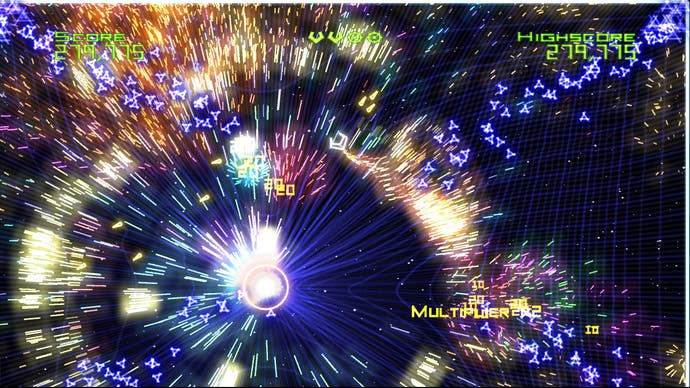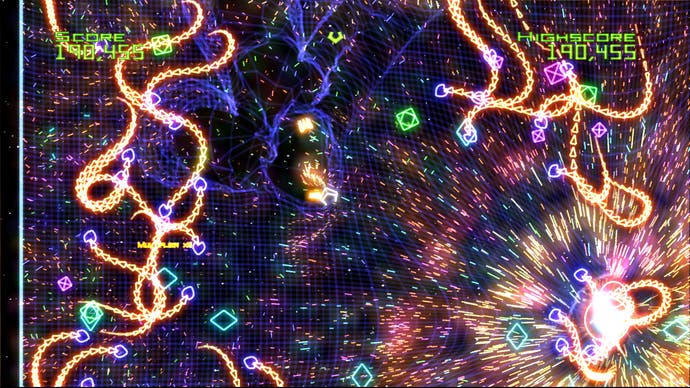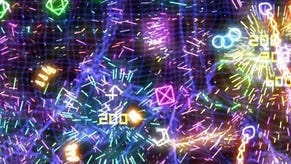Reshaping the past
Geometry Wars picked apart with help from its designer.
Eyes around The Beehive widen and brows furrow in incredulity. I'm suddenly instructed to tell everyone at the table what I've just said to one half. I clear my throat. "The worldwide high score for Geometry Wars is 12.8 million." Nobody says anything. Everyone just thinks about it. "Terrifying," says someone, eventually.
"Mine's 2.1 million, which I originally thought was pretty good," says Stephen Cakebread, creator of Geometry Wars: Retro Evolved and its predecessor, "but I've since been put to shame by all the people who've scored five times that!" Well, six times, but we're not counting. It's too painful.
Meeting the retrograde
Now, to give you an idea of the cross-section of my pub table, we're talking about varying degrees of IT professional - ISP support, network redundancy specialists, etc.; people who keep up with games; people who I've played eight-player Wi-Fi Mario Kart DS with; people whose general reaction to Xbox 360 so far has been virtual indifference.

People who largely all feature somewhere on my Friends list leaderboard for Geometry Wars: Retro Evolved anyway. The fact that I can bring up the 12.8 mil' score and the people there can immediately contextualise it is pretty amazing - especially when you consider that Retro Evolved's a downloadable, one-man-in-a-shed shoot-'em-up that began life as an Easter egg in an Xbox racing game and is only available on a console nobody in the UK can actually buy.
Its success has been truly impressive. It's the most popular Xbox Live Arcade title by far with 200,000 trial version downloads and more than 45,000 paid downloads: nearly a quarter of the people who tried a demo buying the full game is no mean statistic. More than 12,500 people have got a better score than I have, and I've played it for more than ten hours; that might not sound like much to a world of people who've finished Final Fantasy games and see "d" number at the front of their "/played" when analysing a World of Warcraft habit, but then you have to keep in mind at all times that this is a downloadable game. Someone's side-project.
It's particularly impressive when you bear in mind that Cakebread was genuinely worried about how it'd do. "When you've been working on a game for a while it's difficult to feel objective about your creation," he says. "Some folks feel what they're working on is the best thing ever, but I tend to go the other way, so I was thinking, 'Oh my god, how am I going to make this better, it'll never be as good as the original!'"
A bizarre creation
That original began life a long time ago, back when Bizarre Creations - Cakebread's employer - was working on Xbox title Project Gotham Racing. "I actually wrote the first version of the game to test some code for PGR1," says Cakebread. "After PGR shipped I kept tweaking the test code as a hobby project, and it soon started to come together as a game. Folks around the office started copying it to their devkits to play... Eventually one of the producers on PGR2 saw it, and asked me if I'd like to tart it up a bit and have it included in PGR's sequel as an Easter egg."

The idea was incredibly simple, evolutionary of a lot of existing shoot-'em-up casts. Play took place on a square area into which little geometry shapes - enemies - spawned. Controlling a little "ship" of sorts with your left analogue stick, you moved around the area directing an unrestricted stream of laserfire with the right stick. With a system of scoring that increased bonuses exponentially the longer you survived waves of enemies without being hit, power-ups and screen-clearing smart bombs to master, and no theoretical end other than the peak of your own skills, the original Geometry Wars - included with the Retro Evolved 360 download as a bit of extra fun, and enough fun that somebody's got a 20-million-plus score on the leaderboard - became enough of a cult hit that Bizarre wanted to follow it up.
"We wanted to do a sequel to the game, but the eventual decision to do it for Xbox Live Arcade came down to the amount of time I'd be able to spend working on it," says Cakebread when we ask how it ended up on Live Arcade. "If I'd been doing another Easter egg, I'd have been lucky to be able to get a week out of the main schedule, which would never have been enough time to do the game justice! However, because it potentially has its own income, we could afford to spend more time on it. In terms of programming, it's pretty much identical to any normal game, and apart from a few restrictions (such as fitting on a memory unit), generally we're free to do what we want." Cakebread also had help from three people on sound effects, while the chap creating some of the music for Bizarre's Xbox 360 racer PGR3 also contributed music.
The game took "at a rough guess, around three months in total". "All of the code in the original game came over... Twice! Once for the Evolved version, although I obviously did a fair amount of rewriting for that, and once to get the original game in there too."
Live Arcade also appealed, Cakebread says, because the 360's extra power allowed for something pretty. Indeed - the 360 version's underlying game grid is a system of 60,000 points poised in a delicate gravitational balance that reacts beautifully when struck by shockwaves; it runs on the 360's second core along with the audio system. It's a far more dazzling experience than its predecessor all over - the visual style owed a lot to "fireworks and galaxies" apparently. "I spent a rather unproductive few hours looking at pretty pictures on the web!" We'd argue they were quite productive, actually, as would 45,000 other people presumably.
Doing battle

But why is Retro Evolved popular? What's so special about it? Many games do the things it does. Perhaps the difference is that it appeals on a number of levels. One person who thinks so is Leo Tan of PR firm Barrington Harvey, who despite having no association with Microsoft or Bizarre Creations is well known in trade circles for going around telling everyone how great Geometry Wars is, and how he's got the "UK games industry high score" of 970,360. The interesting thing is that he doesn't play it just to lord it over us. "I love the sound, the insanity, the borderline nature of trying to stay alive. It's an assault on the senses. Turn the volume up, the lights down and get an excessive amount of caffeine and chocolate by your side," he says, soundbiting us a little in the process.
When we've calmed him down, he agrees that for others a lot of its appeal is in the way the "creatures" behave. "You only need to see them a couple of times to work it out. After that, it's really as simple as going where there are no bad guys and shooting at where the bad guys are," he says.
That said, for me it's not about defeating recognisable patterns or learning level designs so you can create improbable completion tapes and whack them on Google Video. It's more organic, reflexive. Quite soon you gather how each enemy works, but dealing with them in concert's rarely the same because they move in relation to you and you to them, and they don't spawn the same way on subsequent goes either.
There are letter-shaped purple bastards who chase fast then split into two smaller spinning versions; there are snake-like enemies that twirl around dangerously; others just swarm you without any particular strategy; there are sort-of twirling black holes the bounds of which spit sparks like Catherine wheels. My favourites are the little green ones who chase you while you're heading in the other direction then wimp out when you turn round. "If you shoot them head on they don't duck, only if you shoot slightly to the side of them. It's herding more than shooting," says Tan. The more you play, the more these strategies become innate, and the more you're left to pick up on finer points like that.

"It's all very instinctive. It's about dealing with the situation that arises. The more different situations you can deal with, the further you'll go." Or of course you can just play it without having to think too hard.
On that level, it's the epitome of arcade design and deserves to be Live's arcade poster-child; it's rewarding whether or not you're trying to understand it, but more so if you are. The availability of a demo and the competitive nature of Friends list leaderboards in particular fuels both types of fire. "I think that the limited download size, and trial version requirements will really put the pressure on developers to deliver great games with no wastage," says Cakebread, when asked about GW's success and Live Arcade in general, "so with any luck we'll see some absolutely smashing games come out for it in the near future, and they'll be cheap to boot!"
Mission accomplished
If anything though, the reason Geometry Wars is proving so popular is the variety that everyone's fingers help infuse it with. When no two games are utterly the same and everyone's starting from the same point every time, it's impossible to get left too far behind. And thanks to a couple of decades of exposure to the multi-directional move-and-fire "retro" schemes that Geometry Wars "evolved" from, most of us have a solid base and affinity for it.
12.8 million though.
Oh well, at least I know what I'm doing this evening. Crying in the pub.
Geometry Wars: Retro Evolved is available now on Xbox Live Arcade through Xbox 360. It costs 400 "Microsoft points".



